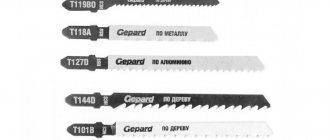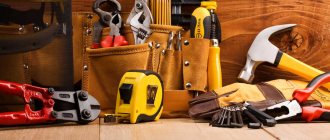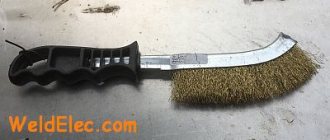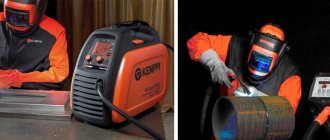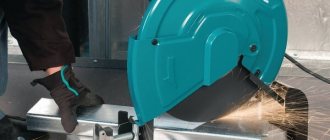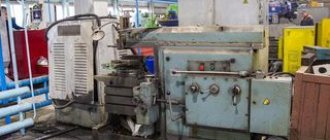How to properly cut metal with a jigsaw
Some power tool manufacturers do not recommend working with metal parts if their thickness exceeds 5 mm. But there are also those that allow you to work with parts up to 10 mm thick. It all depends on the reliability and quality of a particular model. In particular, on the quality of the pendulum assembly.
Before you begin the sawing work itself, you need to carry out some preparation and set up the tool. To properly configure the jigsaw, the pendulum pitch when cutting must be reduced to the first position or removed completely. So to speak, remove the beating of the pendulum. This is done in order to reduce wear on the jigsaw components and avoid dulling the cutting surface of the saw.
It is not necessary to press hard on the jigsaw. You still won’t be able to cut faster, and the risk of damaging the tool increases. The speed of the jigsaw should also not be high. At high speed, you can overheat the cutting element, and this will lead to a decrease in the sharpness and hardness of the saw. Keep in mind that one file may not be enough for the whole job. Especially if you don't have enough experience. Always keep one or two spare parts on hand.
The most common breakdowns, how to avoid them and safety precautions
It is important not only to know how to cut with a jigsaw, but also to try to avoid causes that could lead to the tool breaking.
Electric motor. Most often, the motor fails in jigsaws. There can be several reasons for the breakdown: burnout of the rotor, stator, wear of the notch on the shaft. To avoid rotor burnout, you need to purchase a tool whose power will be sufficient to perform the required tasks. For example, if you need to cut thick workpieces, a jigsaw with a power of 400 W will not be enough - the engine simply will not withstand the load and will burn out. This can also be caused by insufficiently high voltage in the network. It is not recommended to set lower speeds too often: lack of cooling and high currents can lead to winding burnout.
The notch on the shaft may wear out due to constant impact loads on the tool rod. Shock loads on the rod appear due to incorrect selection of equipment. Therefore, always follow the recommendations when selecting a saw blade.
Power button. Sometimes jigsaw owners encounter problems with the power button. Pulling the trigger closes the circuit and starts the engine. If metal dust gets into the case, the normal operation of the power button may be impaired. To remove dust during work, you can use a special vacuum cleaner (a household vacuum cleaner will not work). The failure of the “trigger” can be caused by natural wear and tear of the conductive paths. It must be said that this process is quite lengthy.
Mechanics. Among the mechanical components, the rod can be problematic: this part is subjected to serious mechanical loads that arise during the sawing process. The blade fixing mechanism is the weakest in this system, since it is directly connected to the rod. There is no need to worry about gearbox failures if the housing reliably protects the internal mechanisms of the tool from dust.
Jigsaw safety and maintenance
Basic safety rules must be indicated in the instruction manual. It is strictly forbidden to perform any work while intoxicated. Before starting work, you should make sure that the tool is in working order, that you have safety glasses and gloves, and that the voltage in the network is stable. You need to take care in advance about good lighting of the workplace. Work with a jigsaw should be carried out in a dry room. There should be no flammable substances nearby.
At the end of the work, the tool is thoroughly cleaned of dust and, if possible, blown with air (with the engine running, the blowing efficiency will be higher). Lubricant is applied to moving parts as needed. The instrument should be stored in a dry place. Following these simple recommendations will significantly increase the life of the jigsaw.
Main types of metal files for jigsaws
Now let's move directly to the cutting tools. The inscription on the file itself or on the packaging will tell you that this blade is intended for working with metal. Such products are marked with the inscriptions: “For Metal” or “For Metal,” depending on the manufacturer.
By marking you can find out about the material from which the file is made. The most common steel is HSS. From the manufacturer's description it follows that this is high-speed steel.
Some products are marked BIM. This is a designation for Bimetal, a hard cutting edge and a soft body of the blade. Two materials of different densities are joined by surfacing. The soft body of the blade prevents the brittle steel on the teeth from breaking.
The cutting tool differs in shape. The most popular products are those with small milled wavy teeth. They provide an even cut, with a slight twist if necessary. But such blades cut material 1–3 mm thick.
To cut parts with greater thickness, there are special files with a set “tooth” and modified geometry. The so-called “progressive step”, in which the teeth increase from the jigsaw to the edge of the blade. Such models can cut parts up to 10 mm thick.
A saw with a set tooth can be used to process non-ferrous metals (such as aluminum, copper, brass) and hardwood. They can cut a metal profile (pipe or square) if the diameter does not exceed 30 mm and the wall thickness is 1.2 mm.
Don't be discouraged if you don't succeed the first time. A little patience and attention - and you will succeed!
A jigsaw is a tool for cutting workpieces made of different materials. Most users are familiar with wood sawing products from school. This material will give answers to the questions of what is remarkable about a jigsaw for metal, what groups the tools are divided into and how to choose a good model without overpaying for it.
Tooth blades
Like traditional hacksaws, jigsaws use a serrated saw blade for cutting. There is a wide variety of types of paintings. The gear can differ both in the type of attachment to the jigsaw spindle and in the profile of the teeth themselves.
One of the main parameters of saw teeth is the material used to make the blade . The gear blades can be based on several grades of steel:
- HCS – classic carbon steel
- HSS – high speed tool steel
For cutting metal, it is recommended to use blades based on high-speed steel HSS. Such fabrics are characterized by increased strength and excellent wear resistance . The tooth becomes dull and licks off quite slowly.
The main disadvantage of HSS-based sheets is their high price . This grade of steel is very expensive.
Many manufacturers of equipment for jigsaws for metal are trying to reduce the cost of blades. , Bi-Metal technology is being increasingly introduced . Bimetallic blades are created from 2 grades of steel at once. The blade itself is cheap carbon steel, which has low hardness but exhibits excellent flexibility. The cutting edge (gear) is high-quality HSS steel, which confidently cuts absolutely any metal.
Bi-Metal sheets are very inexpensive. Their price exceeds the cost of analogues from cheap HCS. But such blades are still much cheaper than HSS teeth.
General information about the tool
A jigsaw is a saw whose cutting blade makes a reciprocating motion. Depending on the design, the tool performs from 200 to 3000 vibrations every minute, thereby cutting the metal workpiece.
A jigsaw, unlike most saws (hand saws, miter saws and others), is designed for figure cutting. Moreover, it is difficult for them to get a strictly straight cut line, but a curved one is easy. However, there are products for cutting at right angles. They are equipped with special guides and cost a little more than their analogues, while weighing down the structure.
Experts divide jigsaws for metal into groups according to a number of parameters, including:
- the need to use electricity;
- appointment;
- handle type.
In accordance with the last criterion, the tool is divided into two types:
The former allow you to hold the tool in one hand, which reduces the cutting accuracy, but expands the scope of use. The latter must be held with both hands, having previously fixed the part. This is inconvenient, but the accuracy of cutting the workpiece increases.
The type of handle allows us to classify only manual models. For electric ones, things are different. Next - in detail about other types of cutting tools.
Preparing the tool for work and additional accessories
A jigsaw is a kind of universal device that in some cases can replace a whole range of tools. Before starting work, it is necessary to carry out an external inspection of the tool: make sure the integrity of the power cable, check the connection to the electrical network.
It is also important to choose the right cutting blade - each material being cut has its own requirements. The markings applied to the material must be clear and clearly visible. You can use a laser guide, if one is included with the jigsaw. However, experienced craftsmen, for a more accurate cut, advise focusing on the marks applied to the sole. It is better to perform all work on a saw table - this element can be purchased at the store, or you can arrange it yourself.
A number of manufacturers produce additional devices designed to help perform various operations. The following additional devices will be a good help:
#1. A parallel stop-compass is useful for cutting out circles.
#2. Parallel stop - for straight cuts.
#3. Guide rail - makes straight cutting easier.
#4. Removable pad for the support block - can be made of plastic or metal and is used to increase the glide of the jigsaw over the surface of the material being processed.
#5. Anti-splinter insert - used to reduce the likelihood of chipping during operation, especially relevant when sawing laminated lumber.
Having learned how to use a jigsaw correctly, you can proceed directly to cutting. The choice of saw and operating mode plays a fairly important role in the process of sawing material and operating the tool. If the operating mode is incorrectly selected, the jigsaw may break. Therefore, do not neglect the recommendations described below.
Features of mechanical and electrical models
Depending on the need to use electricity, jigsaws come in two types. Mechanical ones are characterized by a simple design of three main elements (handle, frame and file), lightness, and low cost. The cutting element is fixed in the frame by means of two screw clamps that regulate the tension. If the blade sags, cutting the workpiece (especially metal) is impossible. Working with a mechanical jigsaw is simple, but time-consuming and energy-consuming. The maximum frequency of movements is 200-250 vibrations per minute, so such devices are considered ineffective today. However, to this day they are found in stores.
Example - KRAFTOOL 15606 with an oval frame depth of 165 mm. It makes it possible to cut large metal surfaces. For user convenience, there is a plastic handle with a ribbed surface (so that the device does not slip out of your hands), and durability of use is guaranteed by a tungsten carbide coated blade, which is very wear-resistant and durable. The cost of a mechanical jigsaw is from 700 rubles.
The situation is different with a jigsaw. The tool operates on mains or battery power, makes several thousand oscillations per minute, is compact, durable, and replacement metal files are available in hardware stores. Disadvantages include the weight of the product, noise during operation, and dependence on a power source (when operating network devices). However, the disadvantages pale in comparison with the advantages of modern models, which are discussed in detail in the next section.
Terms of use
Almost everyone knows the general rules of how to use a jigsaw, but there are many important features in working with this device. Of course, it all depends on the material the power tool is working with, but below are some general guidelines.
Tips on how to use a jigsaw:
- There is no need to press in the direction of the cut; the jigsaw should move freely on its own. If the tool does not work, the file is dull. If you put too much pressure on the file, it will move to the side and ruin the cut.
- Here's how to properly use a jigsaw for finishing sawing: the pendulum stroke is set by the regulator to 0, and if thicker boards are being cut in the direction of the grain, then the regulator is set to 1.
- The pendulum mode is used when cutting along the fiber, helping the file not to go to the side.
- During operation, the part must be fixed using clamps. Since you can work with a jigsaw with one hand, some novice specialists, in order to save time, hold the part itself in the second. But in this position it will be impossible to guide the power tool in a straight line. For a more accurate cut and work safety, the part is fixed.
- During work, a lot of dust and sawdust is generated in a short period of time, so using glasses for protection will not be superfluous. If a splinter (especially a metal one) gets into the eye, not only the cut will be damaged, but also the vision.
- In the rules on how to use a jigsaw, it is impossible not to mention that you need to cut not along the intended line, but nearby. This way the cut comes out more accurately and when marking you can avoid including a tolerance for the cut itself.
- To make the cut on the front side smoother and more beautiful, the part is placed face down while working. However, this rule does not apply in the case of thick workpieces. And if there are doubts about the possibility of strictly maintaining the markings on the reverse side in this way, then it is better to use special inserts.
- Sometimes just using a jigsaw as your main tool is not enough. You need to choose the most suitable tool for each manipulation. For example, in woodworking, if the task is simply to saw straight through a long piece in the direction of the grain, a circular saw (if available, of course) or a hacksaw would be more appropriate than a jigsaw. After all, a hacksaw, although rougher, cuts more straight.
- When sawing metal workpieces, it is advisable to use the maximum stroke frequency and turn off the pendulum mechanism altogether.
- How to use a jigsaw from the experience of professionals when working with plastic? It can be taken into account that a high frequency during the cutting process leads to melting, so you need to choose the lowest possible frequency.
- To make the cut exactly straight, you can use a guide limiter. Such a device is attached to the base of the power tool and pressed against the edge of the part.
- If you have to deal with pattern cutting, then first drill a hole for the saw at the point where the marking begins. The saw is inserted into this hole and cutting begins in accordance with the markings.
- To cut a bevel, you need to know how to use a jigsaw at an angle: for this purpose, they have provided the ability to tilt the sole at whatever specific angle is intended.
- When the jigsaw is powered, it is very important to ensure free movement of the cable.
The quality of the saw blades should be even better than the quality of the jigsaw itself, because it is the dull teeth that easily bend in different directions that can ruin the work of even the most experienced craftsman.
In addition, it makes sense to choose different saws for different types of cutting:
- For straight cuts, wide blades are suitable, they have greater stability and, accordingly, ensure a straight line in the end.
- The more important the cleanliness of the cut itself, the finer the teeth on the blade are selected.
- If it is necessary to achieve a perfectly clean cut line, absolutely without a single chip, choose a blade that has a reverse tooth stroke.
- When there is a need for quick and rough cutting, large saws with widely spaced cutters are used.
- Saws without routing are quite productive and convenient for working with thick workpieces.
- If both productivity and cutting quality are equally important, then saws with teeth installed with a displaced pitch will help (at the bottom the pitch is large, and as it approaches the front part of the part it gradually becomes smaller).
Types of electric jigsaws
A self-respecting master of construction has long ago replaced the existing mechanical analogue with a modernized model. All jigsaws are divided into three groups according to the following criteria:
- power;
- duration of work;
- dimensions;
- additional functionality.
In accordance with these parameters, the following are distinguished:
- household;
- professional;
- industrial models.
Household products include low power products up to 600 W. The functionality is somewhat limited (the master will not be able to process surfaces of large thickness), and the operating time does not exceed a couple of hours per day. But it is an indispensable hand tool for solving one-time household tasks. Jigsaws of this type cost from 1000 rubles, which is quite acceptable for a citizen with an average income.
An example of household-type equipment that has many positive reviews is the Bosch PST 700 E. At a price of 3,000 rubles, the user receives a device with a power of 500 W, which is capable of cutting aluminum sheets up to 10 mm thick and steel sheets up to 4 mm thick. Other characteristics are:
- adjustable speed of web movement (from 500 to 3100/min.);
- blowing off chips;
- the ability to cut at an angle due to the tilt of the sole;
- built-in anti-vibration system;
- rubberized staple handle;
- light weight (1.6 kg);
- Possibility of quick blade change.
Bosch PST 700 E is considered one of the best corded jigsaws. Analogues of the device are Makita 4329 K, DeFort DJS-505-B. The functionality is similar, the price varies by 1000 rubles up or down.
Professional models are distinguished by the possibility of long-term daily operation (6-8 hours) due to increased power. The functionality is expanding - along with sheet blanks, the tools can cut aluminum rods and similar products. The cost of professional models is 5-10 thousand rubles, while cheap models do not have a quick clamp for a metal jigsaw file, their speed mode does not change, and the cable is short.
An example device is Makita 4350 CT. Its parameters:
- thickness of sawn steel billet - up to 10 mm;
- saw blade vibration frequency - from 800 to 2800 per minute;
- the presence of a 4-stage pendulum motion (to increase the cutting speed and maintain the quality of the file);
- smooth start, without jerking;
- anti-vibration system;
- Possibility of tilting the sole by 45 degrees;
- weight 2.5 kg.
The product will cost the user 8-9 thousand rubles, depending on the store.
Industrial electric jigsaws are large-sized units that are more appropriately called a machine tool rather than a hand tool. Their power is thousands of watts, their performance is measured by 15-20 hours of daily work, and the cost varies from 10 thousand rubles. An example is a domestically produced tool Zubr ZSL-250 weighing 21 kg and costing 15-17 tr.
Since an advanced user prefers a convenient hand tool, it is worth mentioning the rules for choosing an electric jigsaw.
What to look for before purchasing
The most important thing is not to buy a professional model that will be used once a month, or a household model and try to work with it for 5 hours a day. Therefore, the user should pay attention not only to the power of the jigsaw. Below are some tips for choosing.
- The relationship between workpiece thickness and power. A manual household jigsaw cuts metal up to 4 mm thick, a professional jigsaw cuts metal up to 10-12 mm. It is desirable that both have a power of at least 500 W.
- Functional. Think about whether you should overpay for a tool with lighting, a blowing system, or a pendulum motion, if the device will be used for 1 hour per month? Wide possibilities are welcomed by professionals; an amateur can do without them.
- Possibility to adjust the frequency of saw movements. If the cutting blade can change speed, the tool is good for multiple metals (for example, steel, copper and aluminum). This is due to the fact that thick workpieces (5-10 mm) are cut at reduced speeds, otherwise the file may crack or become dull.
- Choosing a file. It is important to know the type of shank and the method of fastening the file (this is indicated in the technical data sheet of the product). Also, cutting blades are distinguished by their suitability for certain metals, which affects their parameters - pitch of teeth, their number, thickness of the removable element.
Jigsaw device
The following short introduction was compiled to answer the question “What is a jigsaw” and “How does it work.” Since this is only a superficial analysis of the tool, we will not dive into the technical depths, but will only touch on the external functionality. We assure you that the information provided will fully clarify the general understanding of the concept of the device and form a clear picture of the principle of its operation
First of all, you should pay attention to the shapes of jigsaws. They can be staple-shaped or straight with a mushroom-shaped handle
The first option is the most common and very convenient, but for the sake of fairness it is worth saying that working with a mushroom-shaped handle can be quite comfortable (especially in figured cutting).
Regardless of the shape of the handle, each jigsaw has a start button and its lock (for operation without holding). Also, any device of this type has a sole, which can be stamped or cast (on more expensive models). For miter cuts, the sole can be tilted using a key or lever installed on professional devices. Saw blades, making an average of 50 strokes per second, are installed in a special clamp, which can be a block, screw or quick-clamp.
Most modern models are equipped with a pendulum function (to speed up cutting), the regulator of which is located on the left side of the body, next to the file. If we look at the structure of a jigsaw in more detail, we will notice that some models may be equipped with a backlight, a dust collector, a laser pointer and other useful devices. We described these and other functions in detail in a separate article.
For more experienced users who understand the structure of power tools, the following jigsaw diagram has been laid out. The model of a domestic manufacturer presented in analysis clearly demonstrates all the components of the “filling” of most standard devices.
Marking
Whether a metal saw is suitable for a jigsaw for use in a particular application, and whether it is suitable for a tool produced by a particular manufacturer, can be determined by the markings indicated on the blades. Having gained experience in handling a jigsaw, people can easily begin to understand the symbols on the blade. The first letter on it indicates the type of shank.
It may be designated by the letters T, U or M, although there are other standards depending on the instrument chosen. You can also read its dimensions from the markings on the canvas. They are indicated immediately after the letter designating the type of shank. The shortest file is no longer than 75 mm. Medium is considered to have a size in the range of 75–90 mm.
The longest ones are those whose length is from 90 to 150 mm. Following the digital designation is an indication of the size of the teeth:
- small ones are designated by the letter A;
- average – B;
- large - C or D.
There is one more designation indicating the features of the saw:
- the letter F indicates the use of an alloy of two metals in the file material, which ensures special strength of the product;
- the letter P means that the saw allows you to make precise cuts;
- the letter O indicates that the back of the file is particularly narrow, and such a product can be used for curved cuts;
- X: this blade is suitable for cutting various materials, including metal products.
- the designation R is reverse, that is, the saw teeth are directed in the opposite direction.
The color indication on the shank also says a lot. To work with metal, choose products with a blue designation on it. The white color indicates that the file is suitable for both metal and wood processing. Special inscriptions may also indicate the purpose for working with metal objects.
For sawing stainless steel, a blade with the designation Inox is suitable, just for metal – Metal, and for cutting aluminum – Alu.
To work with jigsaws from different companies, saws with a shank of one shape or another are used. T-shaped - developed by Bosch. Today, other manufacturers also use such shanks for their tools. Saws with a similar base are very common on the market. The U-shaped shank is more suitable for jigsaws that have been on the market longer than those made by Bosch. They are combined with a tool that has clamps in the form of blocks. There are also old-style shanks suitable for tools from Bosch and Makita.
It should be taken into account that in addition to files for working with metal, there are those that are used to make cuts on wood, plastic and other materials. In particular, jigsaws powered by electricity were originally intended for wood processing. If saw blades made from an alloy of chromium and vanadium are used to work with wooden products, then blades for working with metal are made of steel, which can quickly cut through durable metal sheets and other things made of such hard material. The stronger the metal being cut, the finer the teeth on the blade. The width of the canvas also varies.
It all depends on what kind of work is supposed to be done. Wide allows you to make a straight cut at high speed without fear of leaving the chosen path. This will also depend on the thickness of the canvas. The thicker it is, the greater the chance of cutting metal in a perfectly straight line. For curly cuts, narrow blades are suitable, allowing you to easily perform intricate turns.
The shape of the teeth on a file designed for cutting metal also matters. Some tools have very small and wavy edges, allowing you to make even cuts, making small turns if desired. These blades are intended for cutting materials with a thickness of 1–3 mm. Blades with set teeth, the number of which increases per inch towards the edge, help cut various metal products or pieces of metal with a greater thickness. They are capable of cutting materials up to 10 mm thick, such as brass, copper and aluminum products and sheets.
How to choose?
When choosing jigsaw files that will be used to process metal in the future, you should consider:
- features of the electric or manual jigsaw available on the farm;
- markings on jigsaw blades;
- type of proposed work.
The brand under which certain saws are produced is also of great importance. It is advisable to give preference to well-known brands and not to buy into the temptingly low price of the product. Behind a fashionable name, in reality, there may be counterfeit products that will bring nothing but disappointment during use. For example, unscrupulous manufacturers often use the Bosh brand to attract attention to their product.
Fake files sold under this brand are created using the stamping method. This can be seen if you look closely at the teeth of such cutting objects. On the one hand, they have a slight rounding, while the original ones have ideal geometry. In addition, branded files can not be purchased individually, but only in appropriate packaging.
When purchasing, you should be wary of any external defects of the product, signaling that you have a defective product in your hands. These can be not only flaws in the metal itself from which the files are made, but also unclear inscriptions and drawings on the canvases. If the marking is printed crookedly, it means you are holding a counterfeit product.
Additional tips for choosing saws
The quality of the saw blades should be even better than the quality of the jigsaw itself, because it is the dull teeth that easily bend in different directions that can ruin the work of even the most experienced craftsman.
In addition, it makes sense to choose different saws for different types of cutting:
- For straight cuts, wide blades are suitable, they have greater stability and, accordingly, ensure a straight line in the end.
- The more important the cleanliness of the cut itself, the finer the teeth on the blade are selected.
- If it is necessary to achieve a perfectly clean cut line, absolutely without a single chip, choose a blade that has a reverse tooth stroke.
- When there is a need for quick and rough cutting, large saws with widely spaced cutters are used.
- Saws without routing are quite productive and convenient for working with thick workpieces.
- If both productivity and cutting quality are equally important, then saws with teeth installed with a displaced pitch will help (at the bottom the pitch is large, and as it approaches the front part of the part it gradually becomes smaller).
Operating rules
Some of these mini-machines are not designed for processing metal products whose thickness exceeds 5 mm. Others make it possible to cut at least 10 mm metal. Much depends on whether the jigsaw is intended for home use or professional use. In order for jigsaw files to serve for a long time, you need to use the tool itself correctly.
- The correct setting of the jigsaw will ensure normal operation of the tool and trouble-free operation of the saw used. It will allow the device to serve as long as possible and will not allow the cutting blade to become dull.
- When working, you do not need to put pressure on the jigsaw. This will not speed up the work, but the prospect of breaking the tool will become quite real. You also need to choose the right speed for the saw. At high speed it can become very hot, becoming less sharp and less hard.
- No matter how skillfully a craftsman uses an electric jigsaw, he should have at least a couple of spare files on hand.
- If a jigsaw is often used for cutting metal, you need to have separate blades for aluminum, non-ferrous metals and steel.
When using a jigsaw for such purposes only occasionally occurs, it is advisable to keep a saw on hand that can cut steel. This file can also handle other metals.
- It is better to have a reserve when using hand tools, although a regular hand jigsaw allows you to continue to use them until a certain length of files is maintained, which makes such a machine quite economical. The clamping elements of a hand jigsaw are designed in such a way that you can always move the saw blade, ensuring that it is securely held and maintaining its tension.
- When working with any jigsaw, you need to wear safety glasses and gloves. And we should also not forget that a file is a very sharp tool and if used incorrectly, a jigsaw can injure a person.
- You cannot “squeeze the juices” out of a dull file, trying to use it for as long as possible. Such treatment may result in poor quality work, and when using an electric unit with a dull blade, the jigsaw begins to work under load and may break.
- When it comes to metal working, nothing lasts forever, especially jigsaw files. But with proper selection and use, you can count on them not becoming a frequently changed consumable.
In the next video you will find an overview of basic Bosch saws for cutting metal products and metal surfaces.
Features of cutting straight elements
This type of work with a jigsaw does not require complex manipulations. It is enough to make a marking and smoothly move the tool along it. But you can also make the process easier by using special devices.
Sawing with a guide bar
This metal ruler has a groove, which is necessary for installing a special jigsaw sole and can greatly simplify the work. When using a guide bar, you first need to make a marking and then fix it. In this case, the jigsaw moves along the device and makes an even cut.
Using the rip fence
All models of jigsaws from Bosch, Interskol and other manufacturers have a hole in the sole for a rip fence bar. This device ensures an even cut of various materials. But when using it, you need to press the jigsaw tightly onto an absolutely flat surface.
Important! It is not recommended to install a parallel stop on parts that will move to the side when cutting.
In most cases, a parallel stop is included with the tool.

